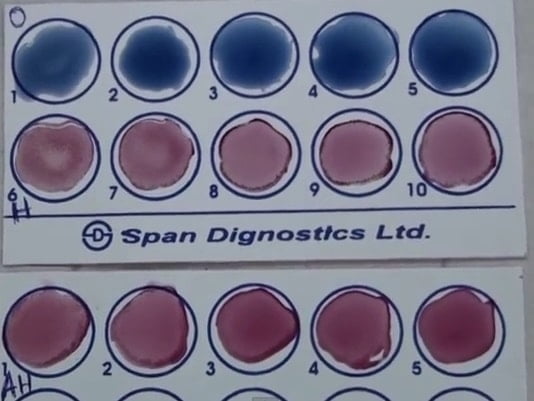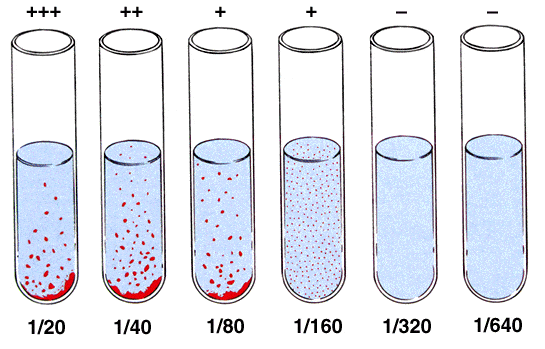Introduction of Widal Test
- Widal Test is an agglutination test which detects the presence of serum agglutinins (H and O) in patients serum with typhoid and paratyphoid fever.
- When facilities for culturing are not available, the Widal test is the reliable and can be of value in the diagnosis of typhoid fevers in endemic areas.
- It was developed by Georges Ferdinand Widal in 1896.
- The patient’s serum is tested for O and H antibodies (agglutinins) against the following antigen suspensions (usually stained suspensions):
S. Typhi 0 antigen suspension, 9, 12
S. Typhi H antigen suspension, d
S. Paratyphi A 0 antigen suspension, 1, 2, 12
S. Paratyphi A H antigen suspension, a
S. Paratyphi B 0 antigen suspension, 1, 4, 5, 12
S. Paratyphi B H antigen suspension, b, phase 1
S. Paratyphi C 0 antigen suspension, 6, 7
S. Paratyphi C H antigen suspension, c, phase 1 - Salmonella antibody starts appearing in serum at the end of first week and rise sharply during the 3rd week of endemic fever. In acute typhoid fever, O agglutinins can usually be detected 6–8 days after the onset of fever and H agglutinins after 10–12 days.
- It is preferable to test two specimens of sera at an interval of 7 to 10 days to demonstrate a rising antibody titre.
- Salmonella antigen suspensions can be used as slide and tube techniques.
Principle of Widal Test
Bacterial suspension which carry antigen will agglutinate on exposure to antibodies to Salmonellaorganisms. Patients’ suffering from enteric fever would possess antibodies in their sera which can react and agglutinate serial doubling dilutions of killed, coloured Salmonella antigens in a agglutination test.
The main principle of widal test is that if homologous antibody is present in patients serum, it will react with respective antigen in the reagent and gives visible clumping on the test card and agglutination in the tube. The antigens used in the test are “H” and “O” antigens of Salmonella Typhi and “H” antigen of S.Paratyphi. The paratyphoid “O” antigen are not employed as they cross react with typhoid “O” antigen due to the sharing of factor 12. “O” antigen is a somatic antigen and “H” antigen is flagellar antigen.
Preparation of Widal Antigens
- H suspension of bacteria is prepared by adding 0.1 per cent formalin to a 24 hours broth culture or saline suspension of an agar culture.
- For preparation of O suspensions of bacteria, the organisms is cultured on phenol agar (1:800) to inhibit flagella.
- Standard smooth strains of the organism are used; S Typhi 901, O and H strains are employed for this purpose.
- The growth is then emulsified in small volume of saline, mixed with 20 times its volume of alcohol, heated at 40° C to 50° C for 30 minutes and centrifuged.
- The antigens are treated with chloroform (preservative) and appropriate dyes are added for easy identification of antigens.
Procedure of Widal Test
SLIDE TEST
- Place one drop of positive control on one reaction circles of the slide.
- Pipette one drop of Isotonic saline on the next reaction cirlcle. (-ve Control).
- Pipette one drop of the patient serum tobe tested onto the remaining four reaction circles.
- Add one drop of Widal TEST antigen suspension ‘H’ to the first two reaction circles. (PC & NC).
- Add one drop each of ‘O’, ‘H’, ‘AH’ and ‘BH’ antigens to the remaining four reaction circles.
- Mix contents of each circle uniformly over the entire circle with separate mixing sticks.
- Rock the slide, gently back and forth and observe for agglutination macroscopically within one minute.
SEMI-QUANTITATIVE METHOD
- Pipette one drop of isotonic saline into the first reaction circle and then place 5, 10, 20, 40, 80 ul of the test sample on the remaining circles.
- Add to each reaction circle, a drop of the antigen which showed agglutination with the test sample in the screening method.
- Using separate mixing sticks, mix the contents of each circle uniformly over the reaction circles.
- Rock the slide gently back and forth, observe for agglutination macroscopically within one minute.
STANDARD TUBE TEST METHOD
In Widal Test, two types of tubes were originally used:
(1) Dreyer’s tube (narrow tube with conical bottom) for H agglutination and
(2) Felix tube (short round-bottomed tube) for O agglutination.
(1) Dreyer’s tube (narrow tube with conical bottom) for H agglutination and
(2) Felix tube (short round-bottomed tube) for O agglutination.
Now a days 3 x 0.5 ml Kahn tubes are used for both types of agglutination.
- Take 4 sets of 8 Kahn tubes/test tubes and label them 1 to 8 for O, H, AH and BH antibody detection.
- Pipette into the tube No.1 of all sets 1.9 ml of isotonic saline.
- To each of the remaining tubes (2 to 8) add 1.0 ml of isotonic saline.
- To the tube No.1 tube in each row add 0.1 ml of the serum sample to be tested and mix well.
- Transfer 1.0 ml of the diluted serum from tube no.1 to tube no.2 and mix well.
- Transfer 1.0 ml of the diluted sample from tube no.2 to tube no.3 and mix well. Continue this serial dilution till tube no.7 in each set.
- Discard 1.0 ml of the diluted serum from tube No.7 of each set.
- Tube No.8 in all the sets, serves as a saline control. Now the dilution of the serum sample achieved in each set is as follows: Tube No. : 1 2 3 4 5 6 7 8 (control) Dilutions 1:20 1:40 1:80 1:160 1:320 1:640 1:1280.
- To all the tubes (1 to 8) of each set add one drop of the respective WIDALTEST antigen suspension (O, H, AH and BH) from the reagent vials and mix well.
- Cover the tubes and incubate at 37° C overnight (approximately 18 hours).
- Dislodge the sedimented button gently and observe for agglutination.
Above protocols are obtained from WIDAL TEST: Swemed Diagnostics
Interpretation of Widal Test
SLIDE TEST

- Agglutination is a positive test result and if the positive reaction is observed with 20 ul of test sample, it indicates presence of clinically significant levels of the corresponding antibody in the patient serum.
- No agglutination is a negative test result and indicates absence of clinically significant levels of the corresponding antibody in the patient serum.
TUBE-METHOD

- The titre of the patient serum using Widal test antigen suspensions is the highest dilution of the serum sample that gives a visible agglutination.
- The sample which shows the titre of 1:100 or more for O agglutinations and 1:200 or more for H agglutination should be considered as clinically significant (active infection). Example: In the above figure, titre is 160.
- Demonstration of 4-fold rise between the two is diagnostic.
- H agglutination is more reliable than O agglutinin.
- Agglutinin starts appearing in serum by the end of 1st week with sharp rise in 2nd and 3rd week and the titre remains steady till 4th week after which it declines.
Limitations of Widal Test
- The Widal test is time consuming (to find antibody titre) and often times when diagnosis is reached it is too late to start an antibiotic regimen.
- The Widal test should be interpreted in the light of baseline titers in a healthy local population.
- The Widal test may be falsely positive in patients who have had previous vaccination or infection with S. Typhi.
- Besides cross-reactivity with other Salmonella species, the test cannot distinguish between a current infection and a previous infection or vaccination against typhoid.
- Widal titers have also been reported in association with the dysgammaglobulinaemia of chronic active hepatitis and other autoimmune diseases.
- False positive Widal test results are also known to occur in typhus, acute falciparum malaria
(particularly in children), chronic liver disease associated with raised globulin levels and disorders such as rheumatoid arthritis, myelomatosis and nephrotic syndrome. - False negative results may be associated with early treatment, with “hidden organisms” in bone and joints, and with relapses of typhoid fever. Occasionally the infecting strains are poorly immunogenic.
- False negative Widal tests may be due to antibody responses being blocked by early antimicrobial treatment or following a typhoid relapse.
- Severe hypoproteinaemia may also prevent a rise in 0 and H antibody titres.
- The antibody levels found in a healthy population however, may vary from time to time and in different areas, making it difficult to establish a cut off level of baseline antibody in a defined area and community.
- In low typhoid endemic areas, weak and delayed O and H antibody responses limit the usefulness of the Widal test. Variations also exist between laboratories in the performance and reading of Widal tests which compromise further the reliability of the test.
- The World Health Organization (WHO) has said that due to the various factors that can influence the results of a Widal test, it is best not to rely too much on this test.




ليست هناك تعليقات:
إرسال تعليق
Due to the high number of spammy comments we have decided to initiate comment moderation so that we can maintain our quality standards and make good environment for our visitors. Please leave your comment